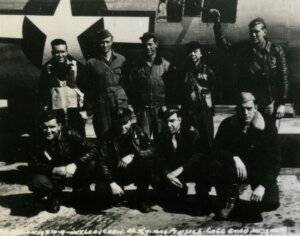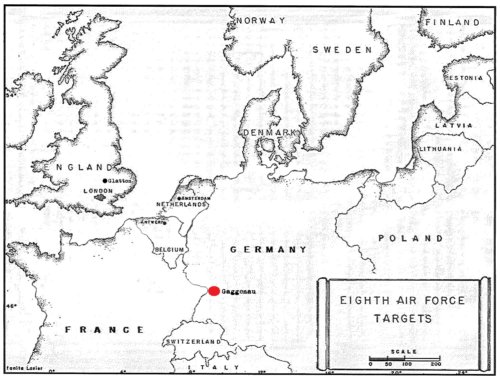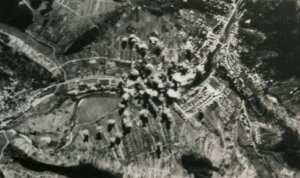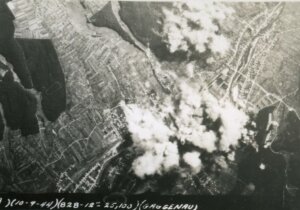TARGET: MOTOR TRANSPORT PLANT
GAGGENAU, GERMANY
10 SEPTEMBER, 1944
Major Smith, as Air Commander, with Lt. Stafford as pilot, led the Group, flying as the 94th B Combat Wing, over the motor transport plant at Gaggenau, Germany. Thirty-six aircraft Comprised the Group’s effort. Three other combat wings were simultaneously dispatched from other 1st Division bases in this coordinated attack on Gaggenau.
 Lead crew with Capt. Doherty and Maj. Peresich
Lead crew with Capt. Doherty and Maj. Peresich
The formation left the English coast and winged its way across the Channel. Entering the Continent a few miles north of the mouth of the Somme River, the Group flew the route as briefed.
Over the continent, aircraft piloted by Lt. Harold D. Gay and Lt. Homer M. Passmore were involved in a mid air collision, and the latter’s plane broke in half just behind the waist door. The navigator and the tail gunner were the only crewmen able to parachute to safety and eventually return to the Base.
Lt. Gay turned back and landed safely at the Base, although two of his crew parachuted from the plane. Ironically, one of the planes was carrying leaflets.
The formation proceeded without further incident toward the IP. Over Metz, only scattered but accurate bursts of flak were encountered. The Group turned on to the bomb run, flying at 25,000 feet, and a visual run was made. By bombs away, the anti aircraft gunners at the target had picked up the formation, and were tracking it for two to three minutes. Their fire was moderate and accurate. Bombing results were fair.
Strike photos of the Gaggenau target
After bombs away, the Group followed the briefed route home. As the formation passed over a point south of Nancy, the craft piloted by Lt. Loren G. Hampton was hit by small calibre fire. The ship was then between 4,000 and 6,000 feet altitude. The pilot crash-landed the aircraft in a field in France. Two of the crew members failed to survive.
The plane piloted by Lt. Paul W. Gilbert also took a hit from flak in two engines. The hydraulic system, intercom and oxygen systems were knocked out and No. 4 engine was on fire. The flight engineer, Sgt. David C. Foltz, went to the waist to determine the condition of the plane and the balance of the crew. In the meantime the pilot, Lt. Gilbert, punched the bail out alarm, but it was inoperative and none of the crew in the rear heard the alarm. Lt. Gilbert set the plane on automatic pilot and along with some members of the crew, bailed out.
In the meantime, Sgt. Foltz made his way back to the cockpit and found it empty. However, having observed the pilot handling the plane over a period of several months, he felt he could keep the ship aloft until it reached the Allied front lines. Other remaining members of the crew concurred and the plane headed west despite No. 4 engine being on fire. For an hour and half, he flew the plane westward until the crew concluded they were over France. At that point, he ordered the crew to bail out, they jumped into friendly territory and all later returned to Glatton. Only after his crew members cleared the craft did Sgt. Foltz parachute to safety. The aircraft ultimately went into a glide and crashed in an open field in France.
For his resourcefulness, determination and self possession under extreme conditions, Sgt. David C. Foltz was awarded the Silver Star. He also received the Purple Heart for wounds received on the mission.
Four bombers had received minor damage and four major damage; three planes were los
Duration of mission 7 hours and 25 minutes
Lt. Edwin B. Benson, 457th/749th bombardier: Mission 5. Gaggenau. Daimler-Benz. Time 7.25. Lead. FLAK
